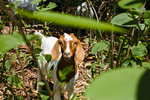REGION – Knotweed is a plant that is an invasive species that originates from Asia and spreads rapidly along streams and rivers.
And it’s everywhere in the Upper Delaware River …
This item is available in full to subscribers.
Please log in to continue |


REGION – Knotweed is a plant that is an invasive species that originates from Asia and spreads rapidly along streams and rivers.
And it’s everywhere in the Upper Delaware River watershed.
There are three types that can be found in this region—Japanese, Giant and Bohemian—and they emerge in late spring growing into full-sized plants by June. At the end of summer they flower and in fall they turn red and set its seeds.
The prolific plant can cause a whole host of problems, such as erosion and soil loss, because its root structure doesn’t retain soils.
It also crowds out other native plants, like trees and shrubs, leading to a lack of diversity that harmfully impacts the habitat.
“Knotweed is a problem that everyone recognizes, but very few people have quantified the problem,” said Steven Schwartz.
He is the Project Manager for the knotweed management project spearheaded by Friends of the Upper Delaware River (FUDR), which seeks to contain, control and eradicate knotweed.
Three test sites have been set up at Skinners Falls in Cochecton, Hancock Firemen’s Field in Hancock and Will Smith Memorial Park in Deposit.
The project uses a variety of management techniques, including cutting, covering with a heavy tarp, spraying herbicide, injecting herbicide into the stem and goats… yes, goats.
Our furry friends will eat many types of plants and can manage knotweed by visiting the patch repeatedly during the year for over more than one year.
The goal of the project is twofold—to study and measure the knotweed and to demonstrate management techniques that people can use at their own homes.
“If I do it on my property, I’d hope that I could help the people upstream from me learn how they can do it on their property,” Schwartz said. “It’s such a wide-ranging problem… it’s something that’s up to all of the individual landowners.”
Over the past two years FUDR has been taking aerial photos of the watershed and the knotweed at different stages of growth. They gave the photos to geographers at Shippensburg University who came up with an algorithm that can identify knotweed.
From the photos they will create digital maps and calculate the percentage of flood plain that has been colonized by knotweed.
This is important because they hypothesize that because knotweed doesn’t have roots that hold soil, during high-water events sediments can be transported into the water, which negatively impacts aquatic habitat and widens and warms the river.
FUDR is being supported in this project by National Fish & Wildlife Foundation, National Park Service, and New York League of Conservation Voters.
Upcoming demonstration events will be held in Hancock on June 19 from 10 a.m. to 1 p.m. and in Deposit on July 17 from 11 a.m. to 2 p.m.
Comments
No comments on this item Please log in to comment by clicking here